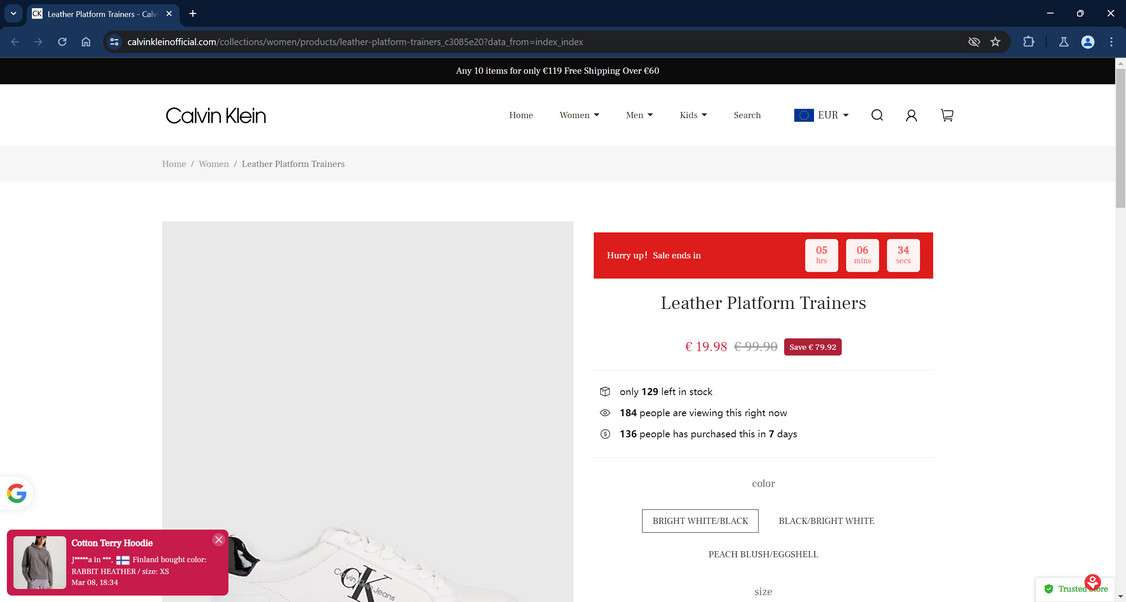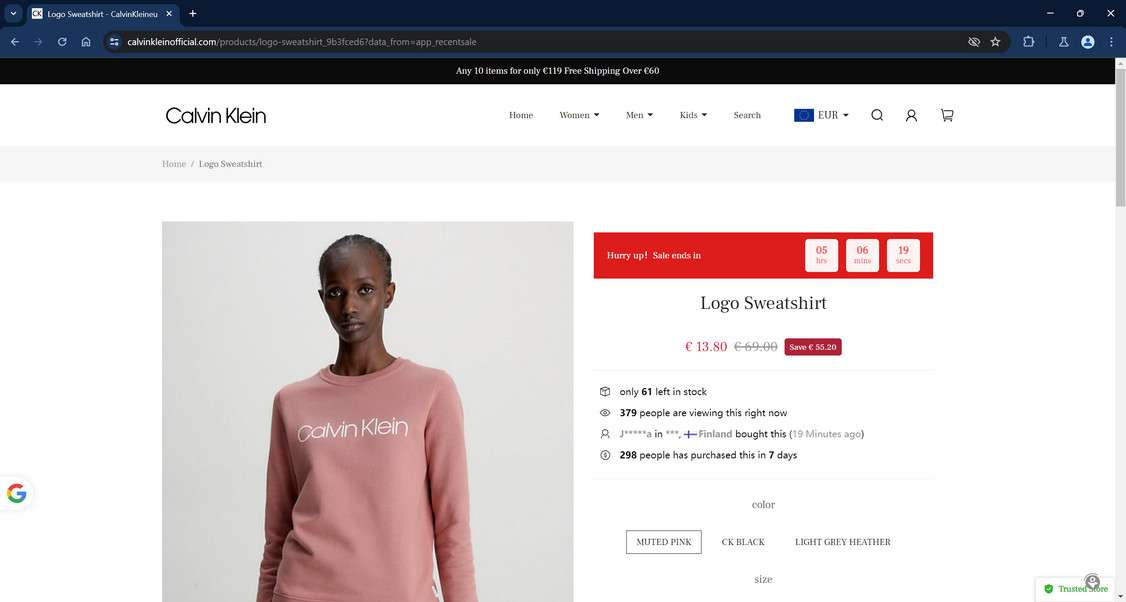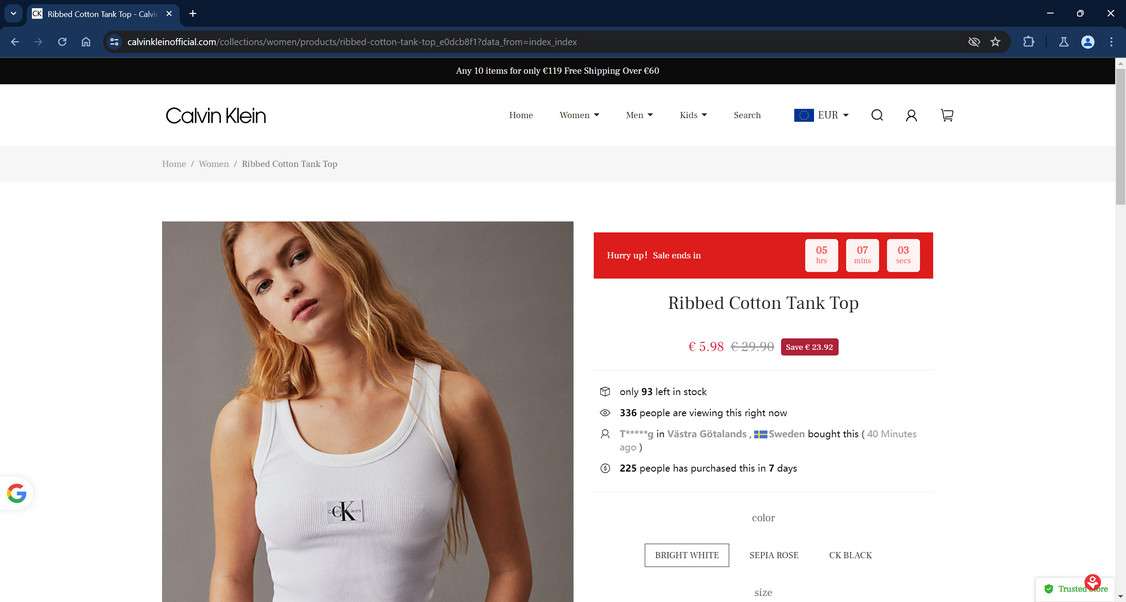Have you seen social media ads or websites advertising unbelievable Calvin Klein deals like 90% off apparel and accessories? As tempting as the blowout prices may seem, these viral promotions claiming to be from Calvin Klein are an elaborate ruse designed to scam shoppers.
Read on to uncover how these sophisticated fashion scams work and how to avoid becoming a victim. You’ll learn the telltale signs across deceptive websites, Facebook ads, Instagram posts, and more that expose the fake markdowns. Don’t let the lure of steep discounts on Calvin Klein products lead you into traps set up by opportunistic fraudsters.



This Article Contains:
Overview of the Fake Calvin Klein Discount Scam
For over 50 years, Calvin Klein has reigned as an iconic American fashion house renowned globally for their apparel, accessories, fragrances, and home furnishings carrying the minimalist CK branding.
This widespread consumer recognition makes Calvin Klein a prime target for opportunistic scammers seeking to exploit their reputation and dupe shoppers. Sophisticated criminals have devised fake Calvin Klein websites, social pages, and online ads that closely mimic the visual aesthetics of Calvin Klein’s official ecommerce experience.
These fraudulent outlets incorporate Calvin Klein’s distinctive black, white and grey color scheme along with the signature logo fonts and photography style into the designs. Many even contain the Calvin Klein name directly in the URL such as “CalvinKleinShoppingOutlet” or “OfficialCalvinKleinStore” to appear more legitimate at first glance.
The scam pages are populated with high-resolution images of clothing, shoes, bags, accessories and home goods stolen illegally from Calvin Klein’s website and catalogs. To the average visitor casually browsing, the imitation sites look convincingly like authorized online Calvin Klein stores.
These fake outlets prominently tout blowout limited-time markdowns on Calvin Klein products using language like “Clearance sale! Up to 90% off!” and “Entire store liquidation – all stock must go!”.
Prices shown are unbelievably low, such as $80 jeans for just $12, $100 dresses reduced to $15, or $150 luggage marked down to $25. These near-free prices are absurd but act as irresistible lures relying on Calvin Klein’s trusted reputation.

The criminals also blanket social platforms like Facebook, Instagram, YouTube, and TikTok with sponsored posts linking to their network of sham sites. The polished ads tout the purported Calvin Klein blowout discounts using similar unbelievable pricing in hopes of driving traffic and conversions.
When a social media user clicks on one of these compelling ads, they are sent to an elaborate fake Calvin Klein web store specifically created for this bait-and-switch scam. Unaware it’s a counterfeit outlet, visitors browse what appears to be a legit authorized Calvin Klein shop stocked with steeply discounted products thanks to the promoted “liquidation sale”.
After adding enough irresistibly priced items to their carts, customers proceed through a convincing checkout process entering credit card and personal data – never realizing the site is an intricate scam operation. No orders are fulfilled, but victims’ financial data is stolen and sold illegally.
By expertly impersonating Calvin Klein’s trusted branding and spamming implausible deals that prey on wishful thinking, the criminals behind these fake discount offers successfully dupe countless online shoppers seeking the name-brand fashion and home goods at amazing savings. But learning to spot their deceptive tactics is key to avoiding getting ripped off.
How the Deceptive Calvin Klein Scam Works
The criminals running these fake Calvin Klein sales go through coordinated steps to successfully pull off their bait-and-switch scam:
1. Crafting Realistic Looking Duplicate Websites
The scammers design imitation Calvin Klein websites featuring familiar branding, models, products and the iconic logo font. Sites may even contain “Calvin Klein” in the URL.
Content like product images and descriptions are copied illegally from CalvinKlein.com. To the average visitor, the fakes appear as legitimate alternate Calvin Klein stores.
2. Promoting Fake Sales on Social Platforms
The fraudsters launch large-scale ad campaigns on Facebook, Instagram, and YouTube promoting their fake blowout Calvin Klein sales, targeting fashion and deal seekers.
The ads tout huge markdowns on jeans, dresses, underwear, accessories and more. Their goal is driving traffic to their counterfeit sites.
3. Duping Shoppers with Deals Too Good to Pass Up
When social media users click on the compelling ads, they are sent to the scam sites and see unbelievable prices on Calvin Klein items thanks to the brand’s reputation.
After adding enough discounted pieces to their cart, they enter their personal and payment data during checkout.
4. Processing Payments But Never Delivering Products
Victims receive order confirmations so it appears their Calvin Klein purchases went through. However, they never receive any actual Calvin Klein products.
Instead, the scammers process payments from victims and either pocket the money or sell the stolen credit card info.
5. Staying a Step Ahead of Blacklists
Before being shut down, the scammers quickly launch new fake websites and social media ads to keep duping shoppers seeking Calvin Klein discounts.
They stay ahead of blacklists by continuously creating new sites and ads faster than old ones can be removed. These key steps allow them to successfully target countless consumers with their network of realistic looking fake Calvin Klein websites and compelling social ads. Playing off the brand’s reputation allows them to deceive many victims.
How to Spot the Deceptive Calvin Klein Discount Websites
While the criminals behind these fashion scams try hard to mimic the real Calvin Klein website, their sham pages do contain certain red flags that can reveal them as fraudulent:
Recently Registered Domain Names
A quick domain registration check often shows these phony Calvin Klein sites were only created within the past few months.
The scammers constantly setup new websites to rip people off, then abandon them once exposed. A recent registration date is a major warning sign.
Suspicious URLs Trying to Appear as Calvin Klein
The website URLs themselves tend to be tipoffs, as they try appearing almost identical to CalvinKlein.com through slight modifications.
Watch for extra terms like “Official”, “Shop”, or “Outlet” in the URL:
- CalvinKleinOutletShop.net
- OfficialCalvinKleinStore.org
- CalvinKleinClothingShop.com
Basically any URL besides the real CalvinKlein.com domain should be treated with serious caution before entering info.
Plagiarized Website Content
The fake sites feature Calvin Klein’s clean black, white and grey template and categories, but lack unique content written specifically for the brand.
All the product photos, descriptions, and pricing are stolen straight from CalvinKlein.com illegally. A real retailer would never completely plagiarize content.
Implausible Discount Levels
Obviously the biggest red flag is deals too good to be true like 90% off the latest clothing collections or $80 jeans for $10.
Other dubious terms used are “limited time only” and “store closing” to create false urgency around the unrealistic deals.
No Contact Information Beyond Email
Highly suspicious indicators are no phone number, physical address, or other valid contact info beyond an email address.
This allows scammers to avoid revealing themselves while still collecting data through order forms. No actual retailer operates without multiple contact methods for shoppers.
Applying extra scrutiny helps spot subtle but consistent patterns across the growing number of fake Calvin Klein websites seeking to bait bargain hunters. Use caution before handing over information or money.
How to Identify the Calvin Klein Scam Ads on Social Media
In addition to the phony websites, a big part of this bait-and-switch scam involves paid ads on platforms like Facebook, Instagram, and TikTok. Learning the warning signs helps avoid falling for them.
Spotting Fraudulent Facebook Ads
The Facebook ads mimic real Calvin Klein promotions with their official branding, models, and captions about warehouse sales. But certain characteristics indicate a scam ad:
- Prices too good to be true like 90% off
- Posts have comments disabled
- Page names contain “Official” or “Shop”
- Links go to shady sites instead of CalvinKlein.com
- High pressure tactics around limited stock
For example, a Facebook ad promoting $150 jeans for just $15. But the implausibly low price screams scam.
Identifying Fake Instagram Ads
On Instagram, the scammers create flashy posts of Calvin Klein models with claims like “Entire online store 90% off for 24 hours!” using attention-grabbing fonts.
Warning signs it’s an Instagram scam include:
- Brand new account posting only “deals”
- No contact information
- Username contains “Outlet” or “Shop”
- Links go to sketchy URLs
- Users can’t comment on the ads
Avoid clicking Instagram ads about unbelievable Calvin Klein deals from accounts you don’t already know are legit.
Recognizing Fraudulent TikTok Videos
On TikTok, the fraudsters post AI-generated videos showing people shopping big sales inside fake Calvin Klein stores. But it’s easy to identify as fake:
- Brand new account
- Promotes implausible discounts
- Shows no real people or locations
- Comments turned off
- Links go to scam sites
The artificial store videos solely exist to direct viewers to the phony websites. No real user created them.
Apply extra diligence before engaging with unbelievable fashion deals on social media that seem just legitimate enough. Always verify before clicking or providing personal information.
What to Do if You Are Scammed By a Fake Calvin Klein Sale
If you placed an order or submitted payment information on a fraudulent website or ad, take these steps:
1. Contact Your Credit Card Provider Immediately
Inform them you suspect fraud and start a chargeback case. Provide any transaction records showing you never received the items.
2. Report Fake Sites to the Real Calvin Klein
Contact Calvin Klein to inform them of counterfeit websites illegally using their name and branding.
3. Reset Any Passwords Used on the Fake Sites
Change the passwords immediately on any accounts used on the scam sites as a precaution and enable two-factor authentication.
4. Place Fraud Alerts on Your Credit Reports
Contact the credit bureaus to place 90-day fraud alerts on your credit reports to prevent identity theft if your information was compromised.
5. Monitor Your Credit Card Statements Closely
Watch statements routinely for any unauthorized charges and report suspicious activity to your bank right away before it compounds.
6. File Complaints With Relevant Agencies
Submit official complaints about the scam websites and ads to the FTC, state attorney general, IC3, BBB, and other consumer protection groups.
7. Warn Others About the Fake Calvin Klein Sales
Share your experience across social channels and consumer posting sites to make others aware of the dangerous clearance sale scam plaguing Calvin Klein.
Taking quick action helps minimize damages from providing data to deceitful sites and reduce risks of further identity theft. Greater awareness about common online shopping scams protects more consumers too.
Frequently Asked Questions About the Fake Calvin Klein Sales Scam
1. Are the viral Calvin Klein ads for 90% off apparel real?
No. Any promotions advertising Calvin Klein products at absurdly low prices like 90% off are fraudulent. While Calvin Klein runs some legitimate sales, prices that seem wildly implausible indicate a scam.
2. What happens if I buy from the fake Calvin Klein websites?
Your credit card will likely be charged but you’ll never receive the Calvin Klein items you ordered. At best you may get cheap, poor quality imitation apparel instead of authentic Calvin Klein pieces. Either way, you lose money and get nothing close to the advertised deal.
3. How can I identify a counterfeit Calvin Klein website?
Watch for red flags like recently registered domains, lack of contact info, unbelievable prices, stolen images, and extra terms like “Official” or “Shop” in the URL. See the “How to Spot Fake Sites” section above for a full list of warning signs.
4. Does Calvin Klein authorize these fake online sales?
No. Calvin Klein does not benefit from or authorize these sham websites misusing their branding and name to scam shoppers. Calvin Klein actively works with authorities to shut down fake sites and social media accounts.
5. Can I get in trouble for buying from the fake sites?
While knowingly purchasing counterfeit goods is illegal, the victims of these scams are generally not the ones who face prosecution – the criminals running the sites do.
6. How do I get my money back if I was scammed?
Immediately contact your credit card provider and request a chargeback for any unauthorized charges. Provide any evidence showing the items were never delivered.
7. What is the best way to report a scam Calvin Klein website?
Use the real Calvin Klein contact info to notify their security team of any fake sites misrepresenting themselves as Calvin Klein. You can also file complaints with the FTC and IC3.
8. How can I avoid these clearance sale scams?
Only purchase Calvin Klein products through the official CalvinKlein.com website and verified authorized retailers. Be very wary of unrealistic discounts and always verify site legitimacy before providing payment info or ordering.
9. Why are there so many fake Calvin Klein sales online?
Calvin Klein’s global popularity as a fashion brand makes them a prime target for scammers seeking to exploit their reputation and dupe shoppers who trust the name and associate it with quality.
10. Do other brands face this type of scam?
Yes, fake online sales scams also frequently target brands like Nike, Adidas, Michael Kors, Coach, Ralph Lauren, and more. Always carefully scrutinize deals that seem too good to be true no matter the retailer.
Be vigilant and only trust Calvin Klein’s real website to avoid getting tricked by the many fake discounts out there. Educating yourself is the best protection against these scams.
The Bottom Line – Verify Before Shopping Any Sales
The extreme markdowns like 90% off new Calvin Klein collections should set off instant warning bells. But scammers bank on temptation overriding caution when faced with deals too good to be true.
This makes it critical we override wishful thinking and carefully scrutinize suspicious Calvin Klein promotions before providing any sensitive information or payment data. Take time to verify site legitimacy.
With expert counterfeits abounding, exercise extra care when unbelievable discounts seem totally implausible, even from a trusted brand like Calvin Klein. Avoid getting duped by only using Calvin Klein’s official online store for all purchases.
Staying vigilant for common online scam red flags and ignoring emotional impulse responses goes a long way to shopping more intelligently and stopping fraud in its tracks. We can dismantle these criminal networks if we educate ourselves on their underhanded bait-and-switch tactics. Don’t become yet another victim of sham fashion sales preying on loyal shoppers and their desire for great deals.










